BIO
Nam Nguyen is Chief Operating Officer at Generate Capital, responsible for the company’s assets and portfolio and operations. Prior to joining Generate, Nam was Executive Vice President at SunPower, one of the largest solar companies in the world.
Nam was responsible for SunPower’s Commercial Solar division, delivering approximately $500 million in revenues and number 1 market share in the U.S. Prior to that, Nam served as Senior Vice President and oversaw SunPower’s power plant business in Latin America, where she was responsible for the P&L, driving approximately 1GW of contracted pipeline and $1.5 billion in revenues. Prior to SunPower, Nam was Vice President of Global Business Development at First Solar. At First Solar, she led the sale and financing of the First Solar project pipeline, including raising $8 billion of financing, and various M&A activities. She also led the expansion of First Solar’s global platform and pipeline. Prior to First Solar, Nam was responsible for corporate development and strategy at a solar start-up OptiSolar, where she helped raise $300 million in venture funding and eventually led the sale of OptiSolar to First Solar. She has also held various roles in investment banking working in New York, Singapore and Los Angeles and is on Generac’s Board of Directors. Nam has a BA in Economics from Columbia University and an MBA from Harvard University and was a Fulbright Scholar.
What investment committees often miss: Investing with an operator's mindset, by Nam Nguyen
The latest data behind the energy transition
A roundup of energy and infrastructure policy headlines
Our favorite articles and reports from the last month
Breaking ground on an innovative new steel mill
Welcome to the March edition of the Generate: Intelligence newsletter. This month, Generate COO Nam Nguyen explores the “operator’s mindset” that is often missing from investors’ approaches to infrastructure projects.
Nam will dive deeper into this topic at a Generate-hosted event on April 23, part of San Francisco Climate Week. Joined by a panel of industry leaders, she will discuss how investors who embrace an operator’s mindset can help bridge the gap between capital and real-world climate solutions. Space is extremely limited—if you’re interested in attending, please reach out to us at Generate.Media@generatecapital.com.
Expert view

By the numbers
Rising demand for LNG
Liquified natural gas (LNG) now accounts for 14% of total US domestic gas demand (BNEF 🔒). This record demand comes as natural gas generation is rising throughout the US (Semafor), and as the Department of Energy approved a permit for a planned LNG terminal facility in Louisiana (Bloomberg 🔒).
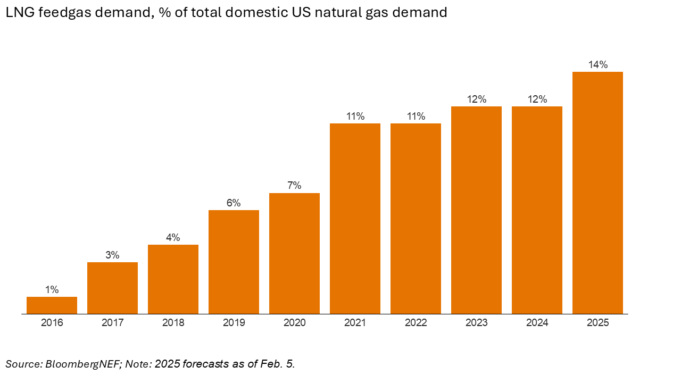
Gas prices are rising
In January, Henry Hub natural gas prices rose above $4/MMBtu for the first time since December 2022 and they remained above this threshold for much of March. Gas equipment prices are also on the rise: a Jefferies write-up on NextEra Energy’s developer day read, “The most quoted statistic of the Developer Day was the $2,400/kW 2030 unplanned combined cycle gas turbine (CCGT) price point which is even higher than the robust data points of late. If there are adverse changes to renewables tax credits, NEE believes that incremental demand for gas could push the pricing towards $3,000/kW.” Gas plays an important role in the US power system and will do so for years to come. But the combination of higher gas equipment costs, extended turbine lead times, and rising fuel prices suggest that an all-of-the-above approach that includes renewables and batteries is more likely to ensure the delivery of timely, reliable and affordable power.
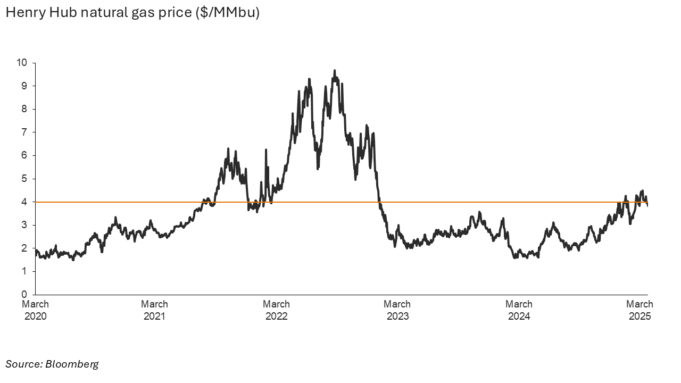
US solar and storage soar to new heights
More 2024 data is coming in as Q1 comes to a close, and it’s showing that US storage and solar both had record years. According to a new US Energy Storage Monitor report (link), the US installed 12.3 GW of energy storage last year, a 33% increase from the preceding year (Latitude Media). Meanwhile, data from a new Wood Mackenzie report reveals the US solar capacity installed in 2024 grew 21% year-over-year (YoY) to 50 GW. Combined, the two technologies made up 84% of the grid capacity added last year (link, link).
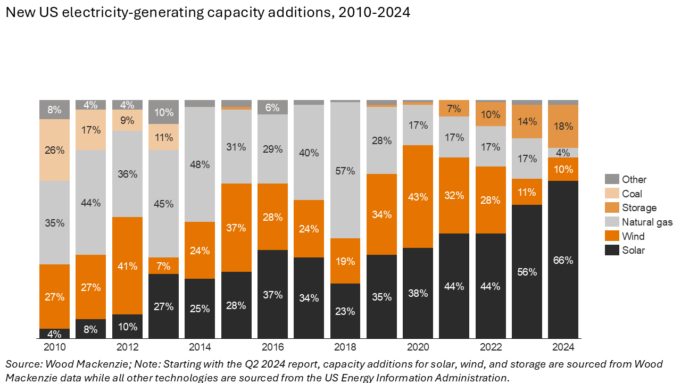
Clean energy uptake is bipartisan
In Texas, solar and storage continue to have a good year in 2025. As spring temperatures heat up, ERCOT added more solar to its fuel mix than ever before. Five different March days topped the grid operator’s previous solar generation record, which was set earlier this year (GridStatus), and renewables accounted for a 76% share of ERCOT’s total load in early March (LinkedIn). The advancement of renewables is especially stark when comparing this month’s grid makeup to five years ago, when solar and storage’s contributions to the Texas grid were almost nonexistent. Long may this continue. As Governor Abbott put it in his State of the State speech this month, “Our rapidly growing state also needs an increasing supply of power.”
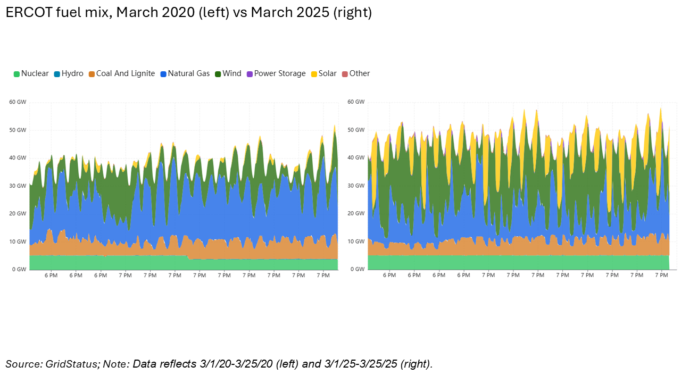
More heatwaves, more gas and coal generation
Even as more renewables capacity is added to the grid, extreme heat is driving up emissions. 2024 was the hottest year ever recorded, and new data reveals how that affected electricity load growth and the generation mix. The year’s hottest months saw a 3.3% YoY increase in US electricity demand with 37% of that increase attributable to air conditioning use, according to a new report from Ember (link). During the June heatwave in the US, electricity demand rose 9.4% YoY. Clean energy covered 67% of the increase, and gas and coal generation rose 4.6% YoY and 6.4% YoY respectively to fill in the gaps.
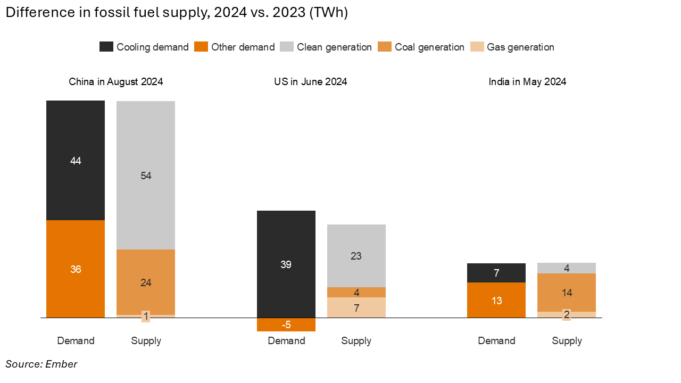
Sunnova shares take a plunge
Shares in residential solar company Sunnova have dropped from $15.26/share at the start of 2024 to $0.35/share as of March 24. The company issued a “going concern” notice in its latest earnings call. The broader US residential solar market also looks challenging, with residential solar permitting down 30% YoY in 2024 and Q4 2024 data showing no signs of rebound that would make for a stronger 2025 (Jefferies).

China’s trade strategy
China’s outward investment has shifted in recent years from acquisitions to greenfield development as companies race to build factories across the world to circumvent tariffs and secure access to markets (High Capacity, Rhodium Group). The strategy is also trying to “kneecap” Indian manufacturing (link).
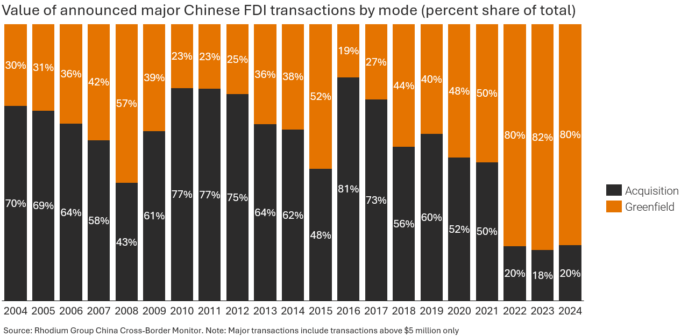
Policy & regulatory highlights
Trade war officially kicks off
The Trump administration enacted 25% tariffs on goods from Canada and Mexico and 10% tariffs on Canadian energy, setting off a chain reaction of retaliatory tariffs (AP, E&E News). Canada swiftly imposed 25% tariffs on $155 billion worth of US products (link), while Ontario announced a 25% surcharge on its electricity exports to Northern US states (AP). Trump also increased tariffs on China (WSJ) and announced a 25% tariff on auto imports (Politico). The European Union threatened to retaliate against US steel and aluminum tariffs (NYT 🔒).
Keeping pace with which tariffs have been enacted or paused is dizzying (see NYT tracker 🔒), as is understanding their potential impact on economic costs (link) and the US electricity grid (GridStatus). Risk frameworks and scenario planning.
CERAWeek reinforces Trump’s energy agenda
US policy makers converged with energy leaders at the annual CERAWeek gathering in Houston earlier this month, providing a glimpse of how the Trump administration’s calls for energy pragmatism and re-embracing gas are being received by influential industry players. US Energy Secretary Chris Wright gave a speech promoting “climate realism” and expediting project permitting (link), while utility CEOs stressed the need for “all of the above” energy strategies to get projects built quickly. The key takeaway? Gas isn’t going anywhere yet – even renewables advocates are now incorporating natural gas into their plans. See more CERAWeek recaps and takeaways from Garrett Golding, Heatmap 🔒, and CTVC.
Legal battle over IRA funding freezes
The fight between the Trump administration and Greenhouse Gas Reduction Fund (GGRF) grant recipients is now tied up in the federal courts. After EPA administrator Lee Zeldin announced he was canceling $20 billion in GGRF grants over stated concerns of programmatic fraud and conflicts of interest (Politico, PoliticoPro 🔒), a federal judge temporarily blocked his claw back effort. Whether grant recipients will be able to reclaim their funds will depend on upcoming court proceedings (PoliticoPro 🔒).
Separately, the EPA’s watchdog office is auditing the $7 billion federal Solar for All program, which finances solar projects in low-income communities throughout the US (E&E News 🔒).
Nuclear gets rare bipartisan support
The Trump administration released a $57 million loan to restore the Palisades Nuclear Plant in Michigan, marking the first restart of a retired American nuclear plant. The Biden administration originally approved the loan as part of the IRA (DOE).
More Republicans back IRA tax credits
As the GOP-led Congress continues to work toward a budget reconciliation bill, 21 House Republicans signed a letter urging party leadership to keep the IRA’s clean energy tax credits intact to prevent spiking energy bills for US residents (Politico). The latest research from think tank Energy Innovation corroborates their concern, showing how an IRA repeal would raise household energy costs (link).
Texas bill threatens renewables momentum
The Texas Senate passed SB388 which effectively requires utilities, generation companies and electric cooperatives in ERCOT to offset new renewable energy and battery capacity with an equal amount of new dispatchable capacity, beginning as early as next year (link, Utility Dive). As Texas – like the rest of the US – works to scale its electricity supply to meet growing demand, the bill threatens to stifle renewables development and limit property owners’ control over their onsite power installations (Doug Lewin). There are plenty of echoes here from the 2022 legislative session, which featured multiple misguided and poorly constructed proposals that ultimately did not pass.
More state & local updates
Legislation introduced last month in California to repair what’s been described as a gross misinterpretation by the California Public Utilities Commission (CPUC) on the directive of Assembly Bill (AB) 2316 could have its first hearing as early as April 2 (NPM 🔒).
Federal Energy Regulatory Commission (FERC) approved changes to PJM’s capacity market rules in February, as part of a filing to change aspects of its Open Access Transmission Tariff, but the Independent Market Monitor told FERC in an March 19 appeal for rehearing that it believes the rule change could lead to higher costs for consumers (NPM 🔒). Various market participants filed comments with FERC urging the commission to reject PJM’s the ISO’s price collar proposal (Utility Dive).
In response to the Trump admin tariffs levied against Canada, New England and New York grid operators set plans to collect millions in tariffs on electricity imports from Canada (Utility Dive, Utility Dive).
A bill to drop an emissions reduction target for investor-owned utilities in North Carolina is making its way through the state’s legislature. The target directs applicable utilities – including the state’s largest utility, Duke Energy – to reduce their emissions by 70% from 2005 levels by 2030 (E&E News 🔒).
What we're reading
Carlyle on “The New Joule Order” (link)
Daniel Yergin’s take on where we are in the energy transition (link) and various rebuttals (link, link)
Eon’s Energy Playbook (link)
The World Meteorological Organization’s State of the Global Climate Annual Report (link)
BCG on landing the economic case for climate action with decision makers (link)
Moving past environmental proceduralism (link)
A review of SBTi’s update (link)
A short update from Michael Liebreich on his “Data Center Power and Glory” post (link)
How data center costs are shifting to consumers (link)
Rhodium report: The potential for geothermal energy to meet growing data center electricity demand (link)
Geothermal has a flock of black swans (link)
How much it costs to build a gas power plant (link)
Princeton report: Potential impacts of electric vehicle tax credit repeal on US vehicle market and manufacturing (link)
Although the auto industry always has its hair on fire, ride hailing has not led to decreased car ownership (link)
The weird and wonderful logic of aluminum (link)
“Abundance”? A book review (link)
An impressive but simultaneously underwhelming video of the Indy Autonomous Challenge (h/t Brian Potter at Construction Physics). Spoiler alert, F1 remains much more fun.
Deal spotlight
Breaking ground on an innovative new steel mill
This month, our partners at Pacific Steel Group broke ground on an innovative steel mill in Kern County, CA, financed in part by Generate. The deal is a case study in how creative credit strategies can help unlock significant decarbonization opportunities for heavy industrial sectors. The mill is expected to reduce the emissions associated with using steel in California by 85% while creating nearly 700 local jobs. To celebrate this milestone, we’ve rounded up media coverage and our teams’ analysis of the project:
- Expert view by Bill Sonneborn: How our latest investment helps mobilize the green steel market (link)
- Op-ed by Bill Sonneborn and Eric Benson: Kern County’s new steel mill will do more than make steel — it will be a long-term community partner (link)
- Infralogic: Generate exec explains rebar manufacturing investment (link)
- Bloomberg: A novel CA steel mill gets $200 million boost (link)

More newsletters
October 2025 Newsletter
Trade policy and House tax bill implications, and more US energy and infrastructure news and analysis
Read moreSeptember 2025 Newsletter
Reflections on RE+ and Climate Week, the role of private credit, who to blame for high electricity prices and a cool Texas summer.
Read moreAugust 2025 Newsletter
Solar investment figures, PPA wariness, and more US energy and infrastructure news and analysis
Read more